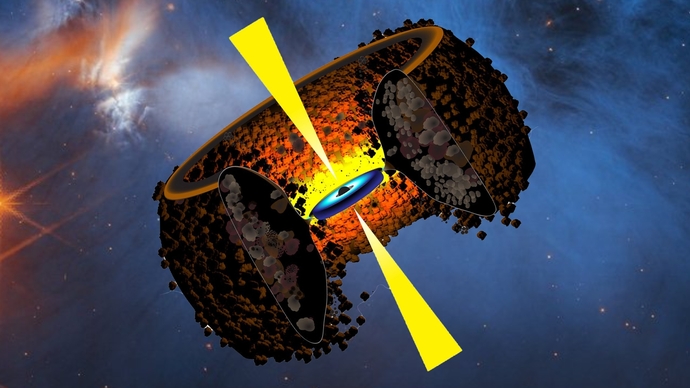
By monitoring the high-energy X-ray emission from accreting supermassive black holes, NuSTAR probes the structure of the surrounding dusty, doughnut-shaped structure and finds evidence that the “torus” is clumpy. This artist’s conception of a clumpy region around a supermassive black hole includes the inner disk of orbiting material and ejected jets. Overlay credit: Bill Saxton, NRAO/AUI/NSF. Background image credit: NASA, ESA, CSA, and M. Zamani (ESA).
NuSTAR News • March 21, 2024
NuSTAR is providing new information about the structures around supermassive black holes. All large galaxies have a supermassive black hole at their center, with a mass millions to billions of times that of the Sun. With an effective radius measured in light-hours, the black hole is tiny compared to the galaxy, whose size is measured in tens of light-millennia. However, when the black hole is rapidly accreting, a hot disk of orbiting material forms and can outshine the hundreds of billions of stars in the host galaxy. This hot, energetic central region produces strong X-ray and ultraviolet light and is embedded in a larger, cooler structure, believed to have a toroidal or doughnut-like shape. However, the structure of this dusty region, including its size and shape, is still broadly unknown. In the last decades, evidence has pointed toward the gas and dust being clumpy rather than smoothly diffuse. This is commonly understood as a collection of clouds orbiting the central supermassive black hole rather than a persistent haze of smog hiding the black hole from view.
Historically, the dusty region was modeled as a uniform torus or a sphere with conical regions carved out above and below the black hole. Recent models, however, consider more complicated structures, including clouds, outflows, and warped disks. To further complicate matters, models generally do not include any physical scale, which means the obscuration could be taking place anywhere between the central black hole and the very edge of the host galaxy.
NuSTAR high-energy X-ray observations, above 10 keV, provide a powerful tool to distinguish changes in intrinsic brightness from changes in obscuration. Using an analogy connected to everyday life, a dimmer lamp could be due to a thicker lampshade or a weaker lightbulb. NuSTAR detects penetrating, high-energy X-rays, which are largely insensitive to any lampshade: dimming seen in the NuSTAR range must be intrinsic to the source (i.e., a dimmer lightbulb) rather than from variable absorption (i.e., a thicker lampshade). Using NuSTAR we can get the best physical picture of what’s happening when we see a source get brighter or dimmer. NuSTAR also detects reflected X-ray emission, which depends on the properties and geometry of the whole torus (i.e., the extent and thickness or opacity of the cloud cover). This provides valuable insight into the global structure, particularly when compared to the line-of-sight properties determined from variable absorption.
In a paper recently published in Astronomy & Astrophysics, Dr. Nuria Torres-Alba of Clemson University and her team measure the scale of the obscurers around supermassive black holes based on NuSTAR monitoring of a sample of nearby sources. Obscuration changes on timescales shorter than a few days would require small structures, likely clouds close to the black hole, while obscuration changes on timescales of years would likely originate from larger, more distant structures.
Dr. Torres-Alba and her team analyzed 53 individual NuSTAR observations of a sample of 12 nearby galaxies known to host a heavily obscured central accreting supermassive black hole. Roughly half of the galaxies (5/12) show clear evidence of obscuration variability on timescales of years, which begs the question: if the torus is clumpy, why do we see variability in less than half of the sources? One clue might come from the observation that sources that show variable obscuration tend to have thicker columns of obscuring material and broader cloud distributions than their counterparts.
Currently, the models of the clumpy torus used by astronomer are not calibrated to consider any of these observational facts. Previous studies tended to be anecdotal, investigating a single object or even a single event, or studies focused on samples of less heavily obscured sources for which less variability due to the dusty torus would be expected. This recent paper is the first comprehensive NuSTAR study of a sample of heavily obscured systems. It provides a new benchmark against which clumpy torus models can be tested, constraining key model parameters such as the number and density of clouds, their sizes, and their orbits.